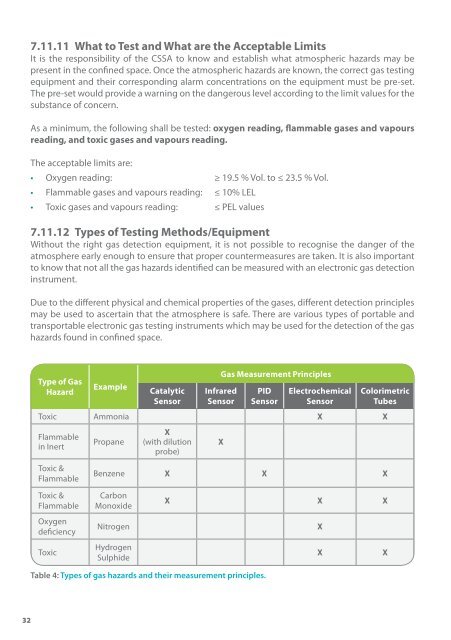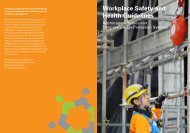Confined Spaces - Workplace Safety and Health Council
Confined Spaces - Workplace Safety and Health Council
Confined Spaces - Workplace Safety and Health Council
- No tags were found...
Create successful ePaper yourself
Turn your PDF publications into a flip-book with our unique Google optimized e-Paper software.
7.11.11 What to Test <strong>and</strong> What are the Acceptable LimitsIt is the responsibility of the CSSA to know <strong>and</strong> establish what atmospheric hazards may bepresent in the confined space. Once the atmospheric hazards are known, the correct gas testingequipment <strong>and</strong> their corresponding alarm concentrations on the equipment must be pre-set.The pre-set would provide a warning on the dangerous level according to the limit values for thesubstance of concern.As a minimum, the following shall be tested: oxygen reading, flammable gases <strong>and</strong> vapoursreading, <strong>and</strong> toxic gases <strong>and</strong> vapours reading.The acceptable limits are:• Oxygen reading: ≥ 19.5 % Vol. to ≤ 23.5 % Vol.• Flammable gases <strong>and</strong> vapours reading: ≤ 10% LEL• Toxic gases <strong>and</strong> vapours reading: ≤ PEL values7.11.12 Types of Testing Methods/EquipmentWithout the right gas detection equipment, it is not possible to recognise the danger of theatmosphere early enough to ensure that proper countermeasures are taken. It is also importantto know that not all the gas hazards identified can be measured with an electronic gas detectioninstrument.Due to the different physical <strong>and</strong> chemical properties of the gases, different detection principlesmay be used to ascertain that the atmosphere is safe. There are various types of portable <strong>and</strong>transportable electronic gas testing instruments which may be used for the detection of the gashazards found in confined space.Type of GasHazardExampleCatalyticSensorGas Measurement PrinciplesInfraredSensorPIDSensorElectrochemicalSensorColorimetricTubesToxic Ammonia X XFlammablein InertToxic &FlammableToxic &FlammableOxygendeficiencyPropaneX(with dilutionprobe)XBenzene X X XCarbonMonoxideNitrogenHydrogenToxicSulphideTable 4: Types of gas hazards <strong>and</strong> their measurement principles.X X XXXXThese instruments may be available either as a single gas monitoring instrument for just onegas or contaminant, or a multi-gas monitoring instrument that will typically measure oxygen,flammable gases <strong>and</strong> toxic gases.It is recommended that for confined space entry testing, whenever possible, use an Ex approvedelectronic gas detection instrument that is capable of detecting OX/EX/TOX simultaneously.Using either diffusion or active sampling via manual or electrical pump will warn the users whenconcentration levels in the confined space are unsafe.It is important that training on the use of these instruments include instrument calibration,equipment maintenance <strong>and</strong> the proper interpretation of the instrument readings <strong>and</strong> warningalarms. When in doubt, it is advisable for the CSSA to check with the instrument manufacturersfor more details.As mentioned, not all gases can be measured with an electronic gas detection instrument.The colorimetric tubes are still a common method used by many gas testers. These tubes areimpregnated with chemicals that will react in the presence of a specific gas or vapour. Thereaction will produce a colour change <strong>and</strong> from the length of the colour change or the intensityof the colour change, the concentration of this gas or vapour can be determined.7.11.13 Testing Procedures <strong>and</strong> ConsiderationsA CSSA shall be appointed to test the atmosphere of a confined space before entry by any personinto the confined space.Steps to be taken before <strong>and</strong> when gas testing is conducted:• Determine equipment type for the atmospheric testing;• Check to see if the atmosphere can be tested from outside. Determine if the atmosphere canbe tested at all depths before entry;• Ensure that the gas testing instrument is calibrated or function tested (refer to 7.11.15.4);• Ensure that the right <strong>and</strong> necessary accessories are used;• Brief all persons concerned on the hazards to be expected, their limit values <strong>and</strong> actionneeded when instrument alarm comes on;• Brief all persons concerned on the emergency procedure, key contacts <strong>and</strong> assembly point;• Use suitable accessories such as water <strong>and</strong> dust filter <strong>and</strong> float probe when sampling fromconfined space with liquid. The sampling hose or sensor may come into contact with theliquid. This could result in contamination of the hose <strong>and</strong> saturation of sensor filters therebyblocking the gas entry to the instrument;• Ensure all depths are tested in the following sequence; start with oxygen, followed byflammable gases <strong>and</strong> vapours <strong>and</strong> finally toxic gases <strong>and</strong> vapours;• Record all results <strong>and</strong> update this information on the entry permit document;• Evaluate <strong>and</strong> determine the frequency of re-tests <strong>and</strong> notify all concerned; <strong>and</strong>• Evacuate everyone in the confined space immediately whenever an atmospheric hazardis detected during entry, while working or when re-tests are done. Re-evaluate the spacethoroughly to determine if the dynamics in it has changed drastically. It is important to takeall required measures before any re-entry is to take place.32 33
















